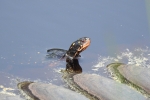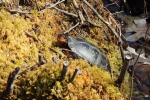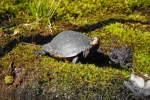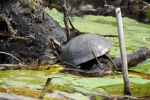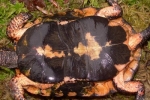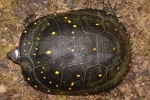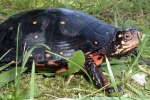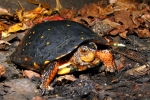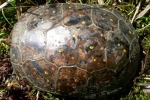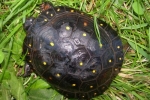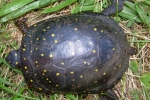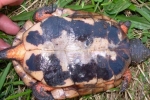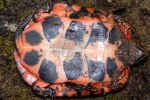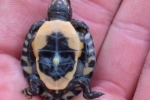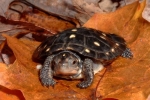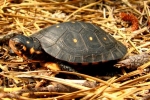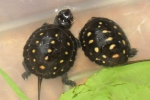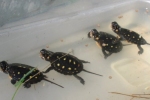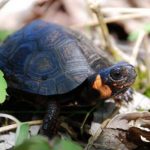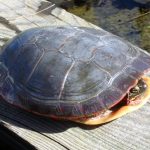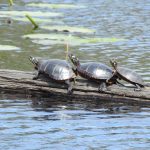Spotted Turtle

Scientific Name: Clemmys guttata
Size: 3.5-4.5 inches (9-11.5 cm) in length
Status: Species of special concern
Habitat:
Marshes, wet meadows, swamps, bogs, and shallow borders of ponds, lakes and streams.
Description:
Small aquatic species. Spotted turtles have black upper shells with many random small bright yellow spots. The spots can occasionally have an orange like tint to them. The underside of the turtle tends to be a combination of black and yellow or black and orange. These turtles often have small yellow spots on the dark colored neck. The skin of the legs is usually black above and orange, pink or red from below. The shell is smooth.
- The carapace background color is jet black with a series of random small bright yellow spots.
- The plastron and ventral surface of the marginals background color is yellow with large black squarelike blotches that cover the entire plastron; with age the plastron may become black.
- The skin of the head, neck, legs, and tail are black above and are orange, pink to salmon red ventrally.
- The head and neck have a series of yellow spots.
- The jaws are yellowish brown.
- Small aquatic species.
- Profile View – The carapace is low.
- Above View – The carapace is oblong or oval in outline.
- The carapace surface and margins are smooth.
- The plastron is very large and the bridge is wide.
- The legs and feet are narrow and the feet have no webbing.
- The head and neck are small.
- The upper jaw is notched.
- The plastral scutes contain black squareish patches.


References:
- Hulse, C. and McCoy C. J. and Ellen Censky ,1998. Amphibians and Reptiles of Pennsylvania and the Northeast. 194-196pp.
- Ernst, Carl H. and Lovich, Jeffrey E., and Barbour, Roger W. ,1994. Turtles of the United States and Canada. 205-212pp.
- Bob Hamilton
- Wayne Fidler
- Brandon Curtis
- Stephen Staedtler
Heads up!
Please contribute your observation of this and other herps to the Pennsylvania Amphibian and Reptile Survey. Your help is needed.
